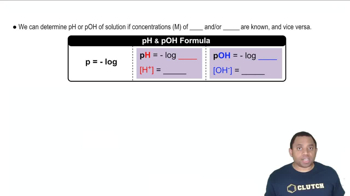Here are the essential concepts you must grasp in order to answer the question correctly.
Weak Bases and Kb
Weak bases are substances that partially ionize in solution, establishing an equilibrium between the un-ionized base and its ions. The base dissociation constant (Kb) quantifies the strength of a weak base, indicating the extent to which it can accept protons from water. A higher Kb value signifies a stronger base, while a lower value indicates a weaker base.
Recommended video:
pH and pOH Relationship
pH is a measure of the hydrogen ion concentration in a solution, while pOH measures the hydroxide ion concentration. The relationship between pH and pOH is defined by the equation pH + pOH = 14 at 25°C. In the context of weak bases, knowing the pH allows for the calculation of pOH, which is essential for determining the concentration of hydroxide ions in the solution.
Recommended video:
Equilibrium Expressions
Equilibrium expressions describe the ratio of the concentrations of products to reactants at equilibrium for a given reaction. For the dissociation of a weak base, the Kb expression is formulated as Kb = [BH+][OH-] / [B], where [B] is the concentration of the un-ionized base, [BH+] is the concentration of the conjugate acid, and [OH-] is the concentration of hydroxide ions. This expression is crucial for calculating Kb from the concentrations at equilibrium.
Recommended video:
Equilibrium Constant Expressions




